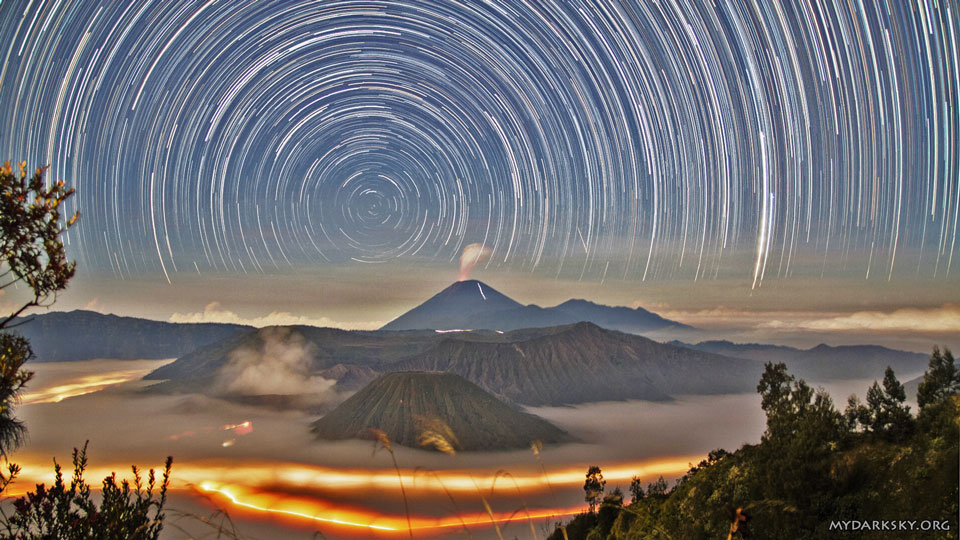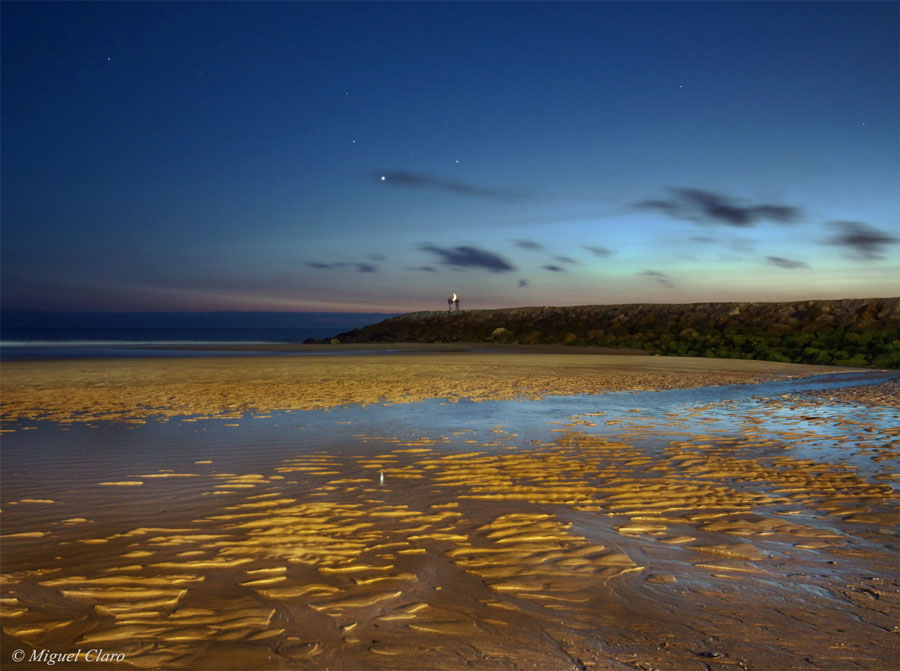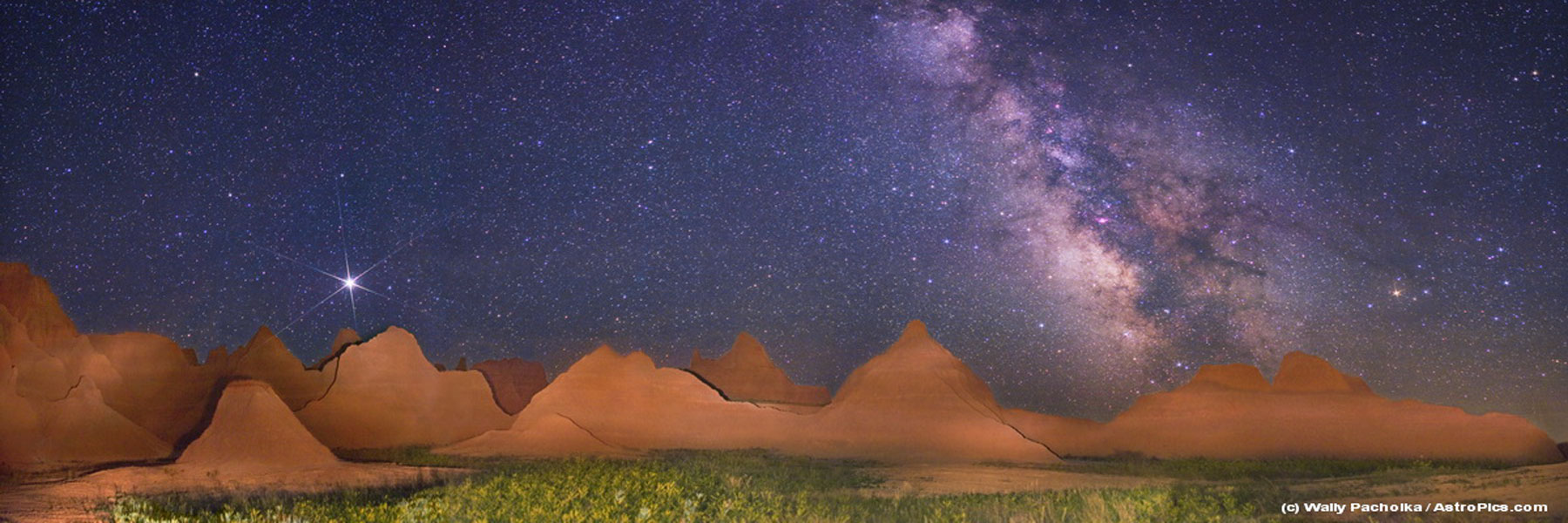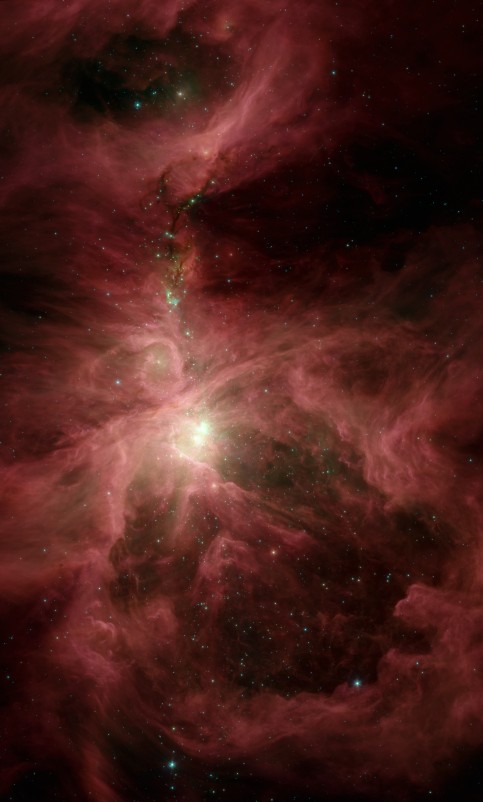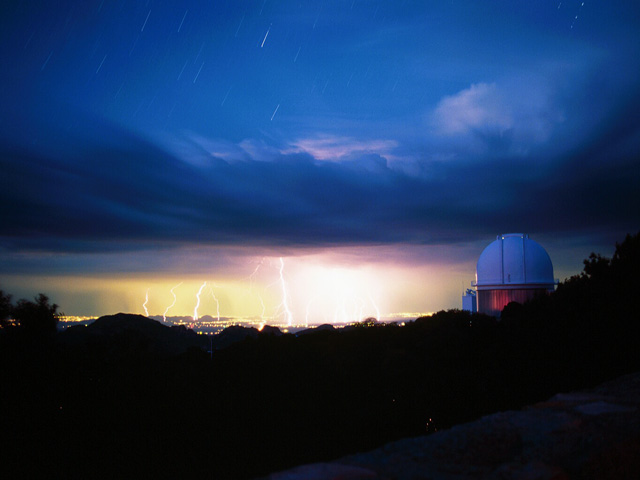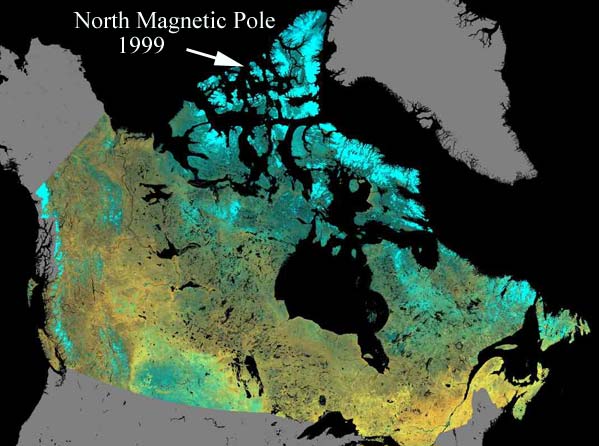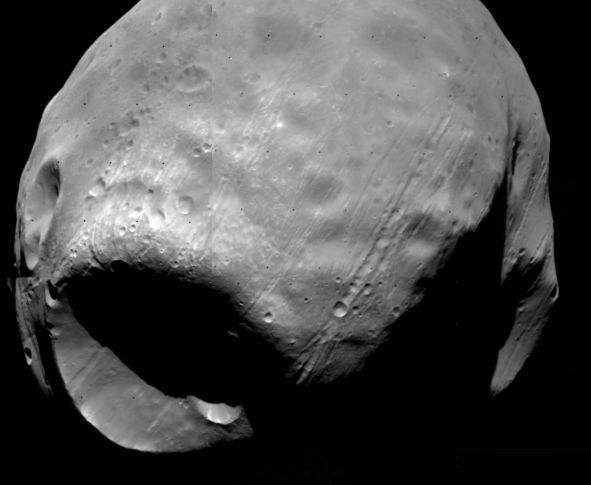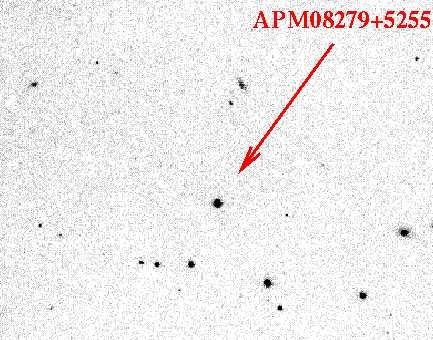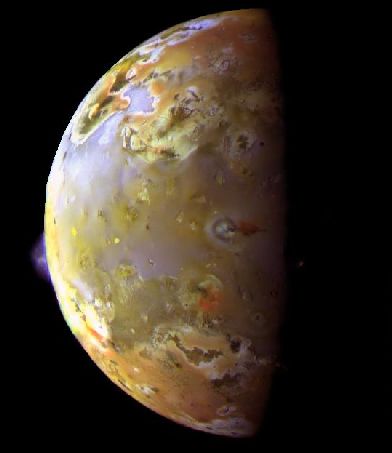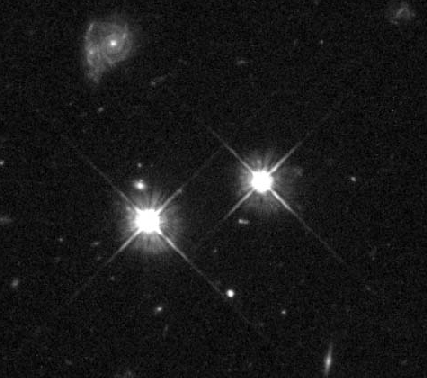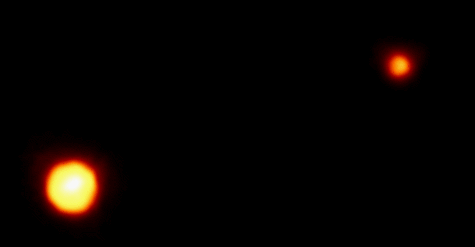| << Previous | Index | Next >> |
2015 Will Comet Catalina become visible to the unaided eye? Given the unpredictability of comets, no one can say for sure, but it seems like a good bet. The comet was discovered in 2013 by observations of the Catalina Sky Survey. Since then, Comet C/2013 US10 (Catalina) has steadily brightened and is currently brighter than 8th magnitude, making it visible with binoculars and long-duration camera images. As the comet further approaches the inner Solar System it will surely continue to intensify, possibly becoming a naked eye object sometime in October and peaking sometime in late November. The comet will reside primarily in the skies of the southern hemisphere until mid-December, at which time its highly inclined orbit will bring it quickly into northern skies. Featured above, Comet Catalina was imaged last week sporting a green coma and two growing tails.
2014 Both land and sky were restless. The unsettled land included erupting Mount Semeru in the distance, the caldera of steaming Mount Bromo on the left, flowing fog, and the lights of moving cars along roads that thread between hills and volcanoes in Bromo Tengger Semeru National Park in East Java, Indonesia. The stirring sky included stars circling the South Celestial Pole and a meteor streaking across the image right. The above 270-image composite was taken from King Kong Hill in mid-June over two hours, with a rising Moon lighting the landscape.
2013 Skylab was an orbiting laboratory launched by a Saturn V rocket in May 1973. Skylab, pictured above, was visited three times by NASA astronauts who sometimes stayed as long as two and a half months. Many scientific tests were performed on Skylab, including astronomical observations in ultraviolet and X-ray light. Some of these observations yielded valuable information about Comet Kohoutek, our Sun and about the mysterious X-ray background - radiation that comes from all over the sky. Skylab fell back to earth on 1979 July 11.
2012 What does the Curiosity rover look like on Mars? To help find out, NASA engineers digitally synthesized multiple navigation camera images taken last week into what appears to be the view of a single camera. Besides clods of Martian dirt, many of Curiosity's science instruments are visible and appear in good shape. Near the middle of the rover is an augmented reality tag intended to enable smartphones to provide background information. Far in the distance is a wall of Gale Crater. As Curiosity will begin to roll soon, its first destination has now been chosen: an intriguing intersection of three types of terrain named Glenelg.
2011 What is that on the horizon? No, it's not an alien starship battling distant Earthlings, but rather a sun pillar. When driving across Ontario, Canada in early June, the photographer was surprised to encounter such an "eerie and beautiful" vista, and immediately took pictures. When the atmosphere is cold, ice sometimes forms flat six-sided crystals as it falls from high-level clouds. Air resistance then causes these crystals to lie nearly flat much of the time as they flutter to the ground. If viewed toward a rising or setting Sun, these flat crystals will reflect sunlight and create an unusual column of light -- a sun pillar as seen above. Such columns of light are not uncommon to see, and a retrospective of past APODs that have featured picturesque sun pillars can be found here.
2010 Sometimes, it's fun to share the sky. Although it might appear that the two sky enthusiasts on the ridge are sharing only a crescent moon between them, three bright planets also stand before them. The brightest point in the sky is the planet Venus, while reddish Mars floats above it, and Saturn shines off to its right. In the foreground are picturesque clumps of sand of the beach at Costa da Caparica, before the reflecting waters of the Atlantic Ocean. The evening picked to planet gaze was a particularly good one as the Perseids meteor shower was also reaching its peak. Fortunately, this evening sky was not unique to Almada, Portugal last Thursday, but visible to sky enthusiasts the world over last week. These planets will all remain visible at sunset this week, although Venus will sink to the horizon as it closes in on the setting Sun.
2009 Why take a picture of just the Badlands when you can take one that also shows the spectacular sky above it? Just such a picture, actually a digital stitched panorama of four images, was taken in late June near midnight, looking southwest. In the foreground, the unusual buttes of the Badlands Wall, part of the Badlands National Park in South Dakota, USA, were momentarily illuminated by flashlight during a long duration exposure of the background night sky. The mountain-like buttes visible are composed of soft rock that show sharp erosion features from wind and water. The South Dakota Badlands also contain ancient beds rich with easy-to-find fossils. Some fossils are over 25 million years old and hold clues to the evolutionary origins of the horse and the saber-toothed tiger. Bright Jupiter dominates the sky on the left just above the buttes, while the spectacular Milky Way Galaxy runs down the image right.
2008 Just before the Sun blacks out, something strange occurs. As the Moon moves to completely cover the Sun in a total solar eclipse, beads of bright sunlight stream around the edge of the Moon. This effect, known as Baily's beads, is named after Francis Baily who called attention to the phenomenon in 1836. Although, the number and brightness of Baily's beads used to be unpredictable, today the Moon is so well mapped that general features regarding Baily's beads are expected. When a single bead dominates, it is called the diamond ring effect, and is typically seen just before totality. Pictured above, a series of images recorded Baily's beads at times surrounding the recent total solar eclipse visible from Novosibirsk, Russia. The complete series can be seen by scrolling right. At the end of totality, as the Sun again emerges from behind the moon, Baily's beads may again be visible -- but now on the other side of the Moon.
2007 On August 1st, a time exposure created this surreal view that looks up into the early morning sky over southern Quebec. Only the light from a nearly Full Moon brightens the sky and highlights the dome of the 1.6 meter telescope at Mont-Megantic Observatory. Shadowy figures on the catwalk are astronomers who have interrupted their work to glimpse the International Space Station (ISS) streaking overhead. The brightest "star" in the moonlit sky, the ISS was easy to spot moving through a background of stars in the high-flying constellation Pegasus.
2006 Few cosmic vistas excite the imagination like the Orion Nebula, an immense stellar nursery some 1,500 light-years away. Also known as M42, the nebula is visible to the unaided eye, but this stunning infrared view from the Spitzer Space Telescope penetrates the turbulent cosmic gas and dust clouds to explore the region in unprecedented detail. At full resolution, the remarkable image data yields a census of new stars and potential solar systems. About 2,300 young stars surrounded by planet-forming disks were detected based on the infrared glow of their warm dust, along with about 200 stellar embryos, stars too young to have developed disks. This 0.8 by 1.4 degree false-color image is about 20 light-years wide at the distance of the Orion Nebula.
2005 Discovered in 1866, main belt asteroid 87 Sylvia lies 3.5 AU from the Sun, between the orbits of Mars and Jupiter. Also shown in recent years to be one in a growing list of double asteroids, new observations during August and October 2004 made at the Paranal Observatory convincingly demonstrate that 87 Sylvia in fact has two moonlets - the first known triple asteroid system. At the center of this composite of the image data, potato-shaped 87 Sylvia itself is about 380 kilometers wide. The data show inner moon, Remus, orbiting Sylvia at a distance of about 710 kilometers once every 33 hours, while outer moon Romulus orbits at 1360 kilometers in 87.6 hours. Tiny Remus and Romulus are 7 and 18 kilometers across respectively. Because 87 Sylvia was named after Rhea Silvia, the mythical mother of the founders of Rome, the discoverers proposed Romulus and Remus as fitting names for the two moonlets. The triple system is thought to be the not uncommon result of collisions producing low density, rubble pile asteroids that are loose aggregations of debris.
2004 Nobody knows what causes lightning. It is known that charges slowly separate in some clouds causing rapid electrical discharges (lightning), but how electrical charges get separated in clouds remains a topic of much research. Nevertheless, lightning bolts are common in clouds during rainstorms, and on average 6000 lightning bolts occur between clouds and the Earth every minute. Above, several lightning strokes were photographed under a starry sky behind Kitt Peak National Observatory near Tucson, Arizona. Lightning has also been found on the planets Jupiter, Saturn, and Uranus. NASA launched the TRMM mission in 1997 that continues to measure rainfall and lightning on planet Earth.
2003 Last Thursday, millions of people had an unexpectedly good view of a dark night sky. Usually, the reflection of city lights off of local air impurities makes it hard for casual observers to see more than a handful of stars from a bright urban area. A large power outage in northeast North America, however, dimmed most city lights and brought unfamiliar celestial wonders to many who looked up. The unexpected starscape was perhaps a small perk in the face of hardships endured by many during the black out. Prominent in the above four-image digital montage are two of the few celestial wonders that can be seen even above the usual glare of city light pollution: the Moon and Mars. Both appear on the far left, with Mars to the upper right of the Moon. Scrolling right will show how eerily dark New York City appeared from across the Hudson River in New Jersey at about 10 pm on 2003 August 14. Visible lights are mostly attributable to cars, local power generators, flashlights, and candles.
2002 A magnetic compass does not point toward the true North Pole of the Earth. Rather, it more closely points toward the North Magnetic Pole of the Earth. The North Magnetic Pole is currently located in northern Canada. It wanders in an elliptical path each day, and moves, on the average, more than forty meters northward each day. Evidence indicates that the North Magnetic Pole has wandered over much of the Earth's surface in the 4.5 billion years since the Earth formed. The Earth's magnetic field is created by Earth's partially ionized outer core, which rotates more rapidly than the Earth's surface. Indicated in the above picture is Ellef Ringnes Island, the location of Earth's North Magnetic Pole in 1999.
2001 Mars, the red planet named for the Roman god of war, has two tiny moons, Phobos and Deimos, whose names are derived from the Greek for Fear and Panic. These Martian moons may well be captured asteroids originating in the main asteroid belt between Mars and Jupiter or perhaps from even more distant reaches of the Solar System. In this 1978 Viking 1 orbiter image, the largest moon, Phobos, is indeed seen to be a heavily cratered asteroid-like object. About 17 miles across, Phobos really zips through the Martian sky. Actually rising above Mars' western horizon and setting in the east, it completes an orbit in less than 8 hours. But Phobos is doomed. Phobos orbits so close to Mars, (about 3,600 miles above the surface compared to 250,000 miles for our Moon) that gravitational tidal forces are dragging it down. In 100 million years or so it will likely crash into the surface or be shattered by stress caused by the relentless tidal forces, the debris forming a ring around Mars.
2000 A bevy of black holes and neutron stars shine as bright, point-like sources against bubbles of million degree gas in this false-color x-ray image from the orbiting Chandra Observatory. The striking picture shows the central regions of two galaxies, NGC 4038 and NGC 4039, locked in a titanic collision some 60 million light-years distant in the constellation Corvus. In visible light images, long, luminous, tendril-like structures emanating from the wreckage lend the pair their popular moniker, the Antennae Galaxies. Galactic collisions are now thought to be fairly common, but when they happen individual stars rarely collide. Instead gas and dust clouds merge and compress, triggering furious bursts of massive star formation with thousands of resulting supernovae. The exploding stars litter the scene with bubbles of shocked hot gas and collapsed stellar cores. Transfixed by this cosmic accident astronomers watch and are beginning to appreciate the collision-driven evolution of galaxies, not unlike our own.
1999 During a total solar eclipse, Earth's moon blocks the sun - almost exactly. While the sun is about 400 times wider than the moon, it is also about 400 times farther away and each appears to be half a degree or so in diameter. On August 11, this remarkable coincidence in the apparent size of two vastly different celestial bodies produced tantalizing solar spectacles for denizens of Europe and Asia. For example, prominences along the sun's limb peer around the moon's dark edge in this dramatic picture of totality recorded as the lunar shadow swept across Hungary. Subtle structures in the sun's inner corona are also visible streaming beyond the silhouetted moon. This total eclipse of the sun was the last to grace planet Earth's skies for this millennium. Although four partial eclipses will occur in the year 2000, the next total eclipse will not be until 2001 June 21.
1998
1997 Two sulfurous eruptions are visible on Jupiter's volcanic moon Io in this color composite Galileo image. On the left, over Io's limb, a new bluish plume rises about 86 miles above the surface of a volcanic caldera known as Pillan Patera. In the middle of the image, near the night/day shadow line, the ring shaped Prometheus plume is seen rising 45 miles above Io while casting a shadow to the right of the volcanic vent. Named for the Greek god who gave mortals fire, the Prometheus plume is visible in every image ever made of the region dating back to the Voyager flybys of 1979 - presenting the possibility that this plume has been continuously active for at least 18 years. This image was recorded on June 28 at a distance of 372,000 miles.
1996 Here is a rather typical quasar. But since quasars are so unusual it is quite atypical of most familiar objects. Of the two bright objects in the center of this photo, the quasar is on the left. The bright image to quasar's right is a star, the faint object just above the quasar is an elliptical galaxy, with an apparently interacting pair of spiral galaxies near the top. Quasars appear as unresolved points of light, as do stars, and hence quasars were thought to be a type of star until the 1960s. We now know that the brightest quasars lie far across the visible universe from us, and include the most distant objects known. Quasars may occupy the centers of galaxies and may even be much brighter than their host galaxies. In fact, the centers of many nearby galaxies have similarities to quasars - including the center of our own Milky Way Galaxy. The exact mechanism responsible for a quasar's extreme brightness is unknown, but thought to involve supermassive black holes. This picture represents a milestone for the six-year-old Hubble Space Telescope as it was picture number 100,000, taken on June 22, 1996.
1995 The Hubble Space Telescope imaged Pluto and its moon Charon in 1994. Pluto is usually the most distant planet from the Sun but because of its elliptic orbit Pluto crossed inside of Neptune's orbit in 1979 and will cross back out again in 1999. Compared to the other planets, very little is known about Pluto. Pluto is smaller than any other planet and even smaller than several other planet's moons. From Pluto, the Sun is just a tiny point of light. Pluto is probably composed of frozen rock and ice, much like Neptune's moon Triton. Pluto has not yet been visited by a spacecraft, but a mission is being planned for the next decade.
| << Previous | Index | Next >> |

